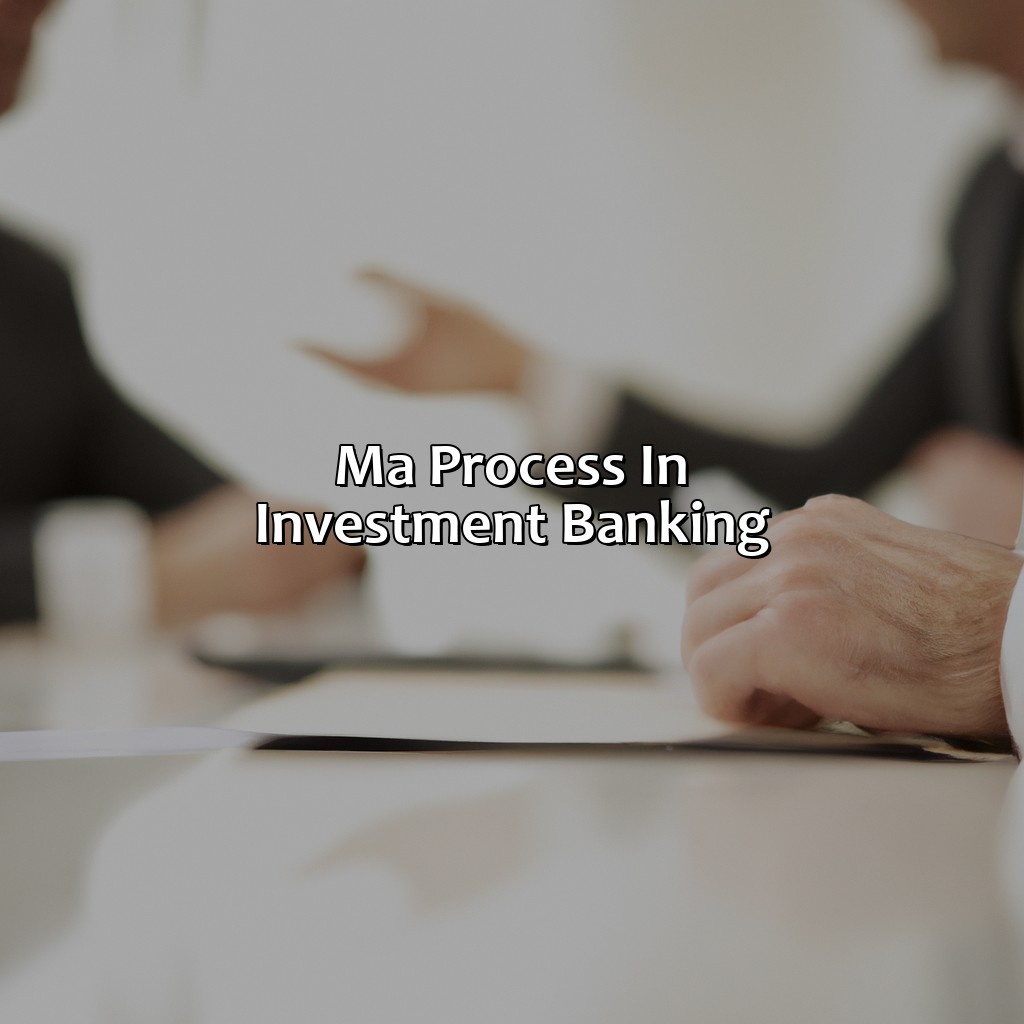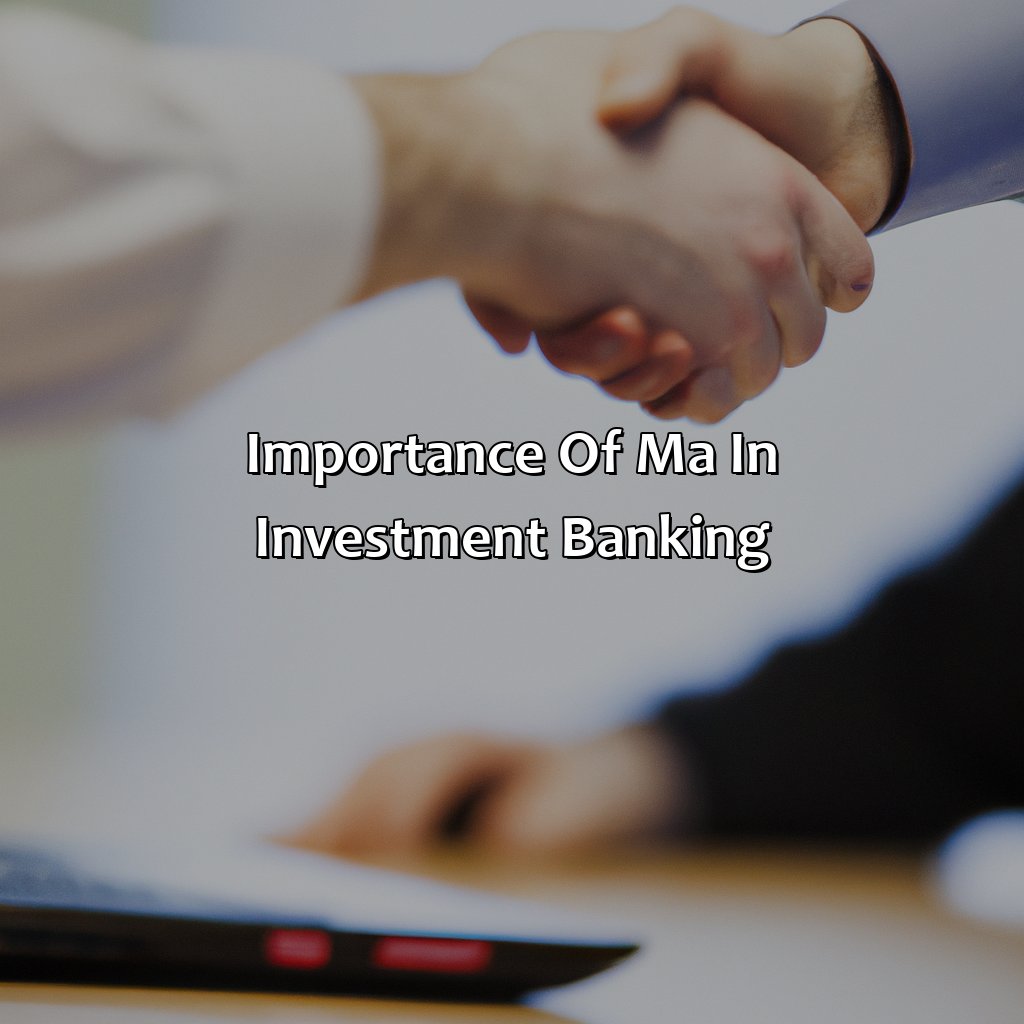What Is M&A In Investment Banking?
Key Takeaway:
- M&A in investment banking refers to the process by which a company merges with or acquires another company in order to expand its business, increase its market share, or gain access to new markets and technologies.
- The M&A process in investment banking involves a series of steps, including due diligence, valuation of the target company, negotiating the deal, and finalizing and closing the deal.
- Due diligence is a critical part of the M&A process, as it involves investigating the target company’s financial and operational performance, legal and regulatory compliance, and other factors that may impact the success of the transaction. Valuation is also important, as it helps investors determine the fair value of the target company and negotiate a fair price for the acquisition.
Are you looking for a deeper understanding of what M&A in investment banking is? This guide will help you gain a comprehensive understanding of the key M&A concepts, processes, and strategies. You will also learn the importance of M&A and how it can benefit investors.
Definition of M&A in Investment Banking
M&A, or mergers and acquisitions, in investment banking refers to the process of combining different companies through various financial transactions, such as buying, selling, or merging. These transactions are typically executed by investment banks, who facilitate the negotiation and execution of the deal. M&A can generate value through synergies, scale, and scope, and can provide opportunities for companies to diversify their offerings, increase market share, and access new markets.
When an investment bank is engaged in an M&A deal, their role may vary depending on the specifics of the transaction. In some cases, the bank may advise one of the companies involved on the deal, while in others, they may represent both parties or facilitate a sale process. Investment banks involved in M&A need to be knowledgeable about valuation, negotiation tactics, and regulatory considerations.
It is important to note that not all M&A deals are successful, and there are many factors that can influence the outcome of a transaction. Issues such as cultural differences between merging companies, regulatory challenges, and unexpected financial obstacles can derail a deal.
Pro Tip: A thorough analysis of the potential risks and benefits of an M&A deal is key to maximizing value and minimizing potential pitfalls. It is important for both parties to engage in detailed due diligence and seek expert advice during the negotiation and execution of the transaction.

Image credits: retiregenz.com by James Jones
M&A Process in Investment Banking
In the investment banking industry, mergers and acquisitions entail a comprehensive process that starts with identifying potential targets, evaluating their financials, assessing deal terms, and executing the transaction. Investment bankers involved in M&A transactions have a responsibility to provide strategic advice and financial guidance to their clients. They use their expertise to facilitate successful transactions that enable their clients to achieve their business objectives and improve shareholder value.
During the M&A process, investment bankers work closely with their clients to develop a strategic plan that aligns with their business goals. They use financial models and other analytical tools to assess the target company’s strengths and weaknesses and determine an appropriate valuation. After identifying a suitable target, the investment banker negotiates deal terms, conducts due diligence, and develops a financing plan.
One crucial aspect of M&A transactions is the integration of the acquired company with the buyer’s existing operations. The investment banker plays a critical role in ensuring that the integration process goes smoothly. By coordinating with both parties, the investment banker can help reduce disruptions to the business and ensure that the transaction delivers on its intended benefits.
Pro Tip: Investment bankers involved in M&A should develop expertise in a specific industry or sector to enable them to provide differentiated advice and insights to their clients.

Image credits: retiregenz.com by Harry Jones
Due Diligence Process
The Investigation Stage of the Merger and Acquisition process involves a meticulous Due Diligence process. It includes a detailed examination of the financials, operations, legal agreements, environmental impact, regulatory concerns, intellectual property rights and any other relevant information. The aim is to gain an in-depth understanding of the target company’s assets and liabilities. Using big data analytics software helps Investment Banks evaluate the performance trends, risk factors and hidden opportunities that contribute to the value estimation during Due Diligence.
In addition to examining documents and data, an on-site visit might be required to assess physical assets and facilities or conduct interviews with employees. Further investigations could also explore cultural compatibility as well as synergy potential between acquiring and target firms for post-merger integration strategy.
During the merger of Company A with Company B, the Investment Bank was surprised by a discrepancy in one of Company B’s contracts that foreclosed certain rights, initially expected in value estimation models. The mistake was made due to an overlooked effort of creating new contract amendments. However, after identifying this issue through Due Diligence analysis they renegotiated terms that accurately realigned Contract obligations before finalizing the deal.
Valuation is like a blind date – you’re not sure what you’re getting into, but you hope it’s worth the price tag.
Valuation of the Target Company
Measuring the Worth of the M&A Objective is a crucial aspect of Investment Banking. Table 1 shows different valuation approaches used by Investment banks. The primary methods involve comparing the company’s value with recent market transactions, analyzing its projected cash flows and comparing them across similar firms in the industry, and evaluating its asset base relative to other companies.
One critical factor that must not be overlooked is calculating potential synergies to determine whether the acquisition will result in cost savings or increase revenue streams.
Pro Tip: Hiring experienced analysts can help streamline and optimize M&A Valuation processes.
Negotiating a deal in investment banking is like haggling at a bazaar, except instead of rugs and spices, you’re bargaining for millions of dollars and egos.
Negotiating the Deal
The process of reaching an agreement in the M&A (mergers and acquisitions) deal is a crucial step in investment banking. During this step, parties involved negotiate the terms of the deal, including the purchase price, payment methods, and other key contractual agreements. A successful negotiation ensures both parties reach mutually beneficial terms and mitigates any potential risks associated with the acquisition.
Negotiating the Deal also involves due diligence and reviewing all necessary documents to make informed decisions. Experts are involved in providing support during these complex negotiations while ensuring deadlines are met. Timely completion of the process guarantees a successful M&A transaction that satisfies all stakeholders’ expectations.
A reasonable offer should be made early on before starting negotiations; it sets a foundation for discussions. Listening actively to both parties is essential to achieve a win-win outcome and avoid unproductive arguments or conflicts that could derail negotiations. Each party must make concessions to finalize the deal successfully.
To ensure that all parties get value for their investments, setting up a strong post-merger integration plan is vital. This plan highlights how different departments would mesh together for effective collaboration and communication within the organization’s merged entity. It reduces cultural differences between companies, eliminates redundancies while maximizing efficiency.
Even after all the due diligence and negotiations, the deal isn’t closed until the fat lawyer sings.
Finalizing and Closing the Deal
The ultimate stage in the M&A process involves sealing the deal through finalizing and closing the agreement. As part of this, both parties must ensure all terms and conditions have been clarified, any outstanding issues resolved, and applicable laws and regulations followed. Once all parties agree on the deal’s details, they then sign it and transfer ownership.
To guarantee an efficient finalization process, investment bankers should create a clear roadmap outlining each step of the way. This may involve drafting legal documents, reviewing due diligence findings, coordinating negotiations between both parties, or securing necessary approvals from relevant regulatory bodies. Attention to detail is critical during these stages to prevent delays or possible future disputes.
Effective communication between all key stakeholders is also vital during these stages to keep everyone informed of progress towards concluding the deal. Investment bankers must actively manage expectations by establishing realistic timelines while ensuring transparency with their clients.
Remember that closing a deal signifies not only financial gains but also possible opportunities to expand capabilities and develop long-term partnerships with new synergies. Don’t miss out on such potential benefits by executing haphazardly or failing to take this stage seriously.
Take charge of this final step and successfully close your next M&A deal today!
Without M&A in investment banking, bankers would have to resort to playing matchmaker at speed-dating events.
Importance of M&A in Investment Banking
In investment banking, M&A (mergers and acquisitions) is a crucial technique utilized by firms to expand their operations and increase profitability. It involves merging companies or acquiring a company to enter new markets. M&A can provide opportunities for companies to develop new technologies, increase market share, and achieve economies of scale. It also benefits the investment bankers by bringing in revenue through fees and commissions.
Successful M&A requires significant knowledge and expertise in areas such as financing, legal regulations, and strategic planning. Understanding the importance of M&A can help investment bankers identify opportunities to generate value for their clients.
While M&A can bring numerous benefits, it also involves significant risks. Companies may face challenges in integrating systems, cultures, and operations. Poorly executed M&A can result in failed deals, missed opportunities, and financial losses. It is essential to conduct thorough due diligence, analyze potential synergies and risks, and negotiate terms that benefit all parties involved. Investment bankers can provide valuable insights and expertise in these areas to help their clients maximize the benefits of M&A.
Pro Tip: Communication and transparency are critical in M&A deals. Ensure all parties are on the same page regarding goals, timelines, and expectations to minimize the risk of misunderstandings.

Image credits: retiregenz.com by Joel Duncun
Potential Risks and Challenges in M&A Transactions
Potential Pitfalls and Complexities in M&A Deals
Mergers and Acquisitions (M&A) transactions can bring about numerous challenges that investors and investment bankers must be aware of. One of the significant complexities is overvaluation, which can lead to an inadequate return on investment. The integration of the two companies can also result in cultural and operational differences, which may impact the success of the M&A. Addressing legal and accounting issues throughout the transaction is another area where significant risks can arise.
Moreover, executing the right strategy, negotiating favorable terms and determining the ideal timing for the transaction can be challenging. All these factors require a high degree of coordination, planning, and analysis to ensure the successful execution of M&A deals.
A Pro Tip for investors and investment bankers is to conduct thorough due diligence to identify potential challenges and devise strategies to mitigate the risks. This would help ensure a smooth transition and a favorable return on investment in the long run.

Image credits: retiregenz.com by Adam Duncun
Recent M&A Deals in Investment Banking
In the world of investment banking, merger and acquisition (M&A) deals play a critical role in driving growth and expanding businesses. Here is a summary of some recent M&A deals in the investment banking industry, showcasing their impact on the finance world.
| Company | Acquirer | Industry | Deal Value |
|---|---|---|---|
| TD Ameritrade | Charles Schwab | Financial Services | $26 billion |
| Fitbit | Technology | $2.1 billion | |
| Raytheon | United Technologies Corp | Defense | $121 billion |
| Aon | Willis Towers Watson | Insurance | $30 billion |
| Tiffany & Co | LVMH | Luxury Retail | $16.2 billion |
Each of these deals has its own unique story and business rationale behind it, resulting in significant changes in the shareholder structures and revenue streams of the respective companies. For instance, the acquisition of TD Ameritrade by Charles Schwab resulted in the creation of a mega-brokerage firm serving millions of clients worldwide.
In the past, M&A deals have often been criticized for being motivated solely by short-term gains and market domination. However, in recent years, the trend has shifted towards a more long-term strategic view, with companies actively seeking out M&A deals to achieve strategic goals, such as diversification or expansion into new markets.
Looking back at the history of M&A deals in investment banking, it is interesting to note that some of the biggest and most controversial deals have involved well-known companies such as ExxonMobil, AT&T, and Time Warner. These deals have often faced regulatory hurdles and intense scrutiny from investor groups, underscoring the importance of careful planning and execution in the M&A process.

Image credits: retiregenz.com by Adam Woodhock
Future Outlook of M&A in Investment Banking
The forward-looking perspective of M&A in investment banking anticipates continued growth in the M&A market, with a strong focus on technological investments and cross-border mergers. Increased regulatory pressures and complexity will demand innovative strategies and expertise from investment banks to ensure successful deals. The use of artificial intelligence and predictive analytics will enhance efficiency and accuracy in evaluating potential targets on a global scale. Diversifying into new markets and industries will be necessary for sustained success.
Investment banks must adapt to a changing landscape by incorporating innovative approaches to deal-making, such as adopting advanced technology to increase accuracy and efficiency. Ensuring a strong team of experts with extensive knowledge in niche industries and global markets will be imperative. Developing strategies that align with clients’ goals, while mitigating risks, will be crucial to securing successful deals. In addition, increased collaboration and partnerships with other financial institutions will help to facilitate cross-border transactions.
As global markets continue to evolve, investment banks must stay ahead of the curve by identifying emerging trends and innovations. Strategic partnerships, investments in technology, and diversification into new markets are essential to remain competitive. By understanding clients’ needs and providing innovative solutions, investment banks will continue to play a vital role in the M&A market.

Image credits: retiregenz.com by Yuval Duncun
Some Facts About M&A in Investment Banking:
M&A stands for mergers and acquisitions, which are transactions in which companies combine or one buys the other. (Source: Investopedia)
Investment banks play a crucial role in M&A deals, providing financial and strategic advice to companies. (Source: The Balance)
M&A transactions can be friendly or hostile, with hostile takeovers being more rare and controversial. (Source: Forbes)
One of the largest M&A deals in history was the acquisition of Time Warner by AOL in 2000, valued at $165 billion at the time. (Source: CNBC)
The M&A market can be unpredictable, with many deals falling through due to regulatory hurdles, financial issues, or other factors. (Source: Financial Times)
FAQs about What Is M&A In Investment Banking?
What is M&A in investment banking?
M&A stands for mergers and acquisitions. It is a strategic practice where two or more companies come together to merge and form a new entity or one company acquires another. Investment bankers in M&A help companies handle the complexities of deals, such as strategic planning, valuations, negotiations, and financing.
What is the role of investment bankers in M&A?
Investment bankers in M&A act as advisors to clients looking to merge or acquire another company. They provide strategic advice on how to structure a deal, conduct financial analysis, determine valuation, identify potential targets, and raise capital. Their primary role is to help clients achieve their strategic goals in the most efficient and profitable way possible.
What are the benefits of M&A for companies?
M&A can offer many benefits for companies, such as increased market share, expanded product lines, diversified customer base, improved economies of scale, reduced competition, and increased profitability. It can also be a way for companies to enter new markets, gain access to new technology, or simply grow their business quickly.
What are the risks of M&A for companies?
M&A can also come with risks, such as integrating different cultures, systems, and processes, managing employee layoffs and morale, dealing with regulatory hurdles, and potential financial losses. Companies must carefully weigh the benefits and risks of any M&A deal before moving forward.
How do investment bankers value companies in M&A?
Investment bankers use various methods to value companies in M&A, such as discounted cash flow analysis, comparable company analysis, precedent transaction analysis, and leveraged buyout analysis. These methods take into account factors such as financial performance, growth potential, industry trends, market share, and competitive landscape.
How long does the M&A process usually take?
The M&A process can take several months to over a year to complete, depending on the complexity of the deal, regulatory requirements, and other factors. It typically involves several stages, such as initial discussions, due diligence, negotiation of terms, and closing. The investment bankers play a critical role in managing the process and ensuring that it runs smoothly and efficiently.
 Checkout this IRS Loophole
Checkout this IRS Loophole 
